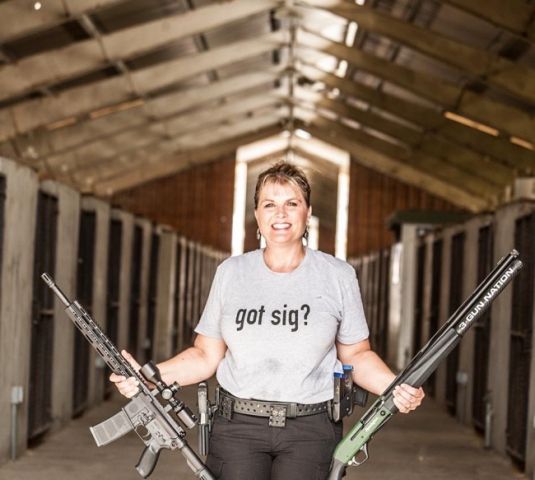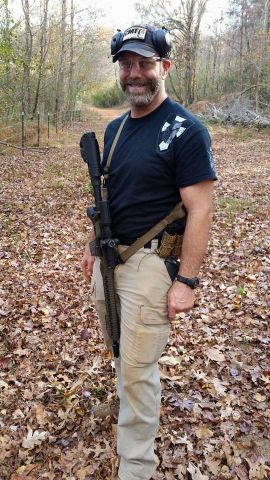Have you ever thought of incorporating firearms into your physical fitness routine? Believe it or not, the idea is not a new one.
In 1785 Thomas Jefferson wrote to his fifteen-year-old nephew, Peter Carr, regarding what he considered the best form of exercise: ‘…I advise the gun. While this gives a moderate exercise to the body, it gives boldness, enterprize, and independance to the mind.’ —Text from James A. Bear, “Some Jefferson Ideas on Exercise, Guns and Game,” Monticello Research Report
Every 12 months we get an opportunity to take a moment to reflect on the year that’s passed, and plan for how we want to do things differently or better in the year that’s just being born. We have all seen the cartoon depiction of Baby New Year, the diaper-clad toddler that represents the unspoiled opportunity to raise this “baby” right. And with proper care, feeding, and attention to this infant’s needs, we have hope of prosperous times ahead. We all say, for instance, that we will commit to exercising more and getting physically fit. What if you could incorporate firearms into your physical fitness? Now, that would be a fitness routine you’ll follow through on.

Firearms enthusiasts know the fitness benefits of the shooting sports because they experience them firsthand, even if they aren’t fully aware of why they feel so healthy after an afternoon of shooting. While hunters engage in a very physical activity, by hiking and packing in in the fresh outdoor air, simply going out for an afternoon of plinking has beneficial health aspects as well.
I decided to ask some experts for their thoughts on this topic, and was fortunate to connect with Brian Hill, owner of The Complete Combatant, and Tamara Brown Templeton, a registered nurse at the U.S. Department of Veterans Affairs.
What do you see as fitness advantages to taking firearms training?
Brian: I have been a Martial Arts student in the Marietta, Georgia, area since I was 14, and an instructor since I was 18. Training and instructing in combative firearm techniques, martial arts and physical fitness have always been my passion. As far as the physical benefits of the shooting sports, we have to use several key assets when we shoot. First is the ability to find a stable shooting stance, which requires the body to work synergistically, using balance, coordination and the core muscles to assist in recoil management and target tracking. Developing a good grip strengthens the hands and forearms. The eyes have to change focus from target to front sight, thus strengthening the ciliary muscles of the eye, which control the shape of the lens. As you progress as a shooter you will move from position to position, working on your agility and speed.

Tamara Brown Templeton
Fine motor skills must be used for many aspects of shooting, such as loading magazines and making incremental adjustments to control aim. These all speak to mental focus and upper-body conditioning. How else are physical health and the shooting sports interrelated?
Tamara: I’ve been an RN for 13 years, most of which has been at the VA Hospital in Gainesville, Florida; I am also a beginner competitive 3-Gunner. With any firearms training, and especially combat or self-defense training, you are learning a new kind of balance. You have to not only keep your own body’s balance in check, but also have to balance the gun. One reason is safety on the training range; secondly, acquisition of your threat into your sights while possibly moving; and thirdly, overall control of the situation. This requires another level of core strength and mental awareness. This type of training forces you to sharpen your situational awareness as well. It helps to have a certain level of physical fitness to hold your gun up for long periods if needed, and good flexibility for reaching for concealed weapons and accessories, as well as the possibility of having to shoot from crouched or awkward positions. Having the ability to bend in any direction safely while maintaining the direction of your weapon requires, again, a good combination of core strength, flexibility and situational awareness.
Are the benefits strictly physical in nature, or are there other positive aspects?
Brian: I proudly serve as a board member at Racheal’s Rest, which is a 501(c)(3) nonprofit organization that offers private counseling and five-day restorative retreat programs designed to address the physical, emotional and spiritual needs of survivors of sexual abuse or acts of violence to help regain their balance in life. Addressing mental health and the internal mental benefits of the shooting sports is as important as addressing the physical aspects. The mental discipline of shooting will teach you how to focus, and how to quiet the mind so that only necessary information is being processed. Having a small explosion of a discharging firearm directly in front of you, while managing your trigger and aligning the front sights, is a great way to develop concentration. The act of drawing, aiming and firing in short period of time allows the shooter to deal with stress and manage many tasks at once. Strategies for developing skills lead to discipline in training and patience. Most important, shooting is an enjoyable activity, and is great for lifting our moods.

Brian Hill
The release of endorphins and the building of a sense of pride are an inherent part of gaining proficiency in any new skill. What else can people expect to experience as they engage in the shooting sports?
Tamara: The benefits of firearms training go far beyond the physical. After a successful lesson and shooting session, you gain confidence in your skills and your ability to protect yourself. As you progress in your training, this confidence continues to grow, and self-esteem and positive mental self-assessment come into play. When you see your performance improve, it can improve your outlook on your total being. Plus, when practicing “real-life” situational drills, the adrenaline rush and release of endorphins add to the thrill of hitting the mark on your target.
Thank you so much for your help in gaining a better understanding of the physical and mental benefits of firearms training. As a health-care provider, Tamara, do you have any other thoughts you would like to leave with our readers, or any advice on what sports our readers might look into?
Tamara: I would ask your readers what other exercises they do outside the range to be sure they are in good physical condition when it comes time for shooting. I’ve seen people who are overweight shooting competitively and they do well, except when it comes to fast movement through a course, like running; then they seem to have a slight disadvantage. There may be a correlation between the physical demands of the shooting sport a person chooses and a shooter’s willingness to physically prepare for it. I shoot 3-Gun and I found out in the first few matches the importance of having a better than average cardiovascular health, so you aren’t winded at the end of a course when you’re trying to aim your handgun or taking a 200-yard shot with an AR15. Sporting-clay shooters may work their upper body more, since they have to swing a longer (and usually heavier) shotgun through the air repeatedly during a match. There are so many variables—just about as many as there are shooting sports. And I’m sure there will be some who do no physical preparation at all, and say it’s all a mental game. I think there’s probably some truth to that, too.
Brian, with your varied background in coaching competitive martial artists and athletes, do you have any words of advice for someone who is thinking of incorporating firearms training into a healthy lifestyle?
Brian: Will shooting make you a great athlete? Probably not—but it will make you more active and give you more incentive to improve your fitness level, once you realize that the most important gear is you and not the gun.
Cheryl Todd is the executive producer and co-host of “Gun Freedom Radio,” owner of AZFirearms Auctions, Pot Of Gold Auctions and founder of the grassroots movement Polka Dots Are My Camo. Cheryl is the Arizona state director for The DC Project and travels the country speaking as a champion for our Second Amendment rights. She is a driving force in preserving the legacy of freedom for generations to come. View all posts by Cheryl Todd